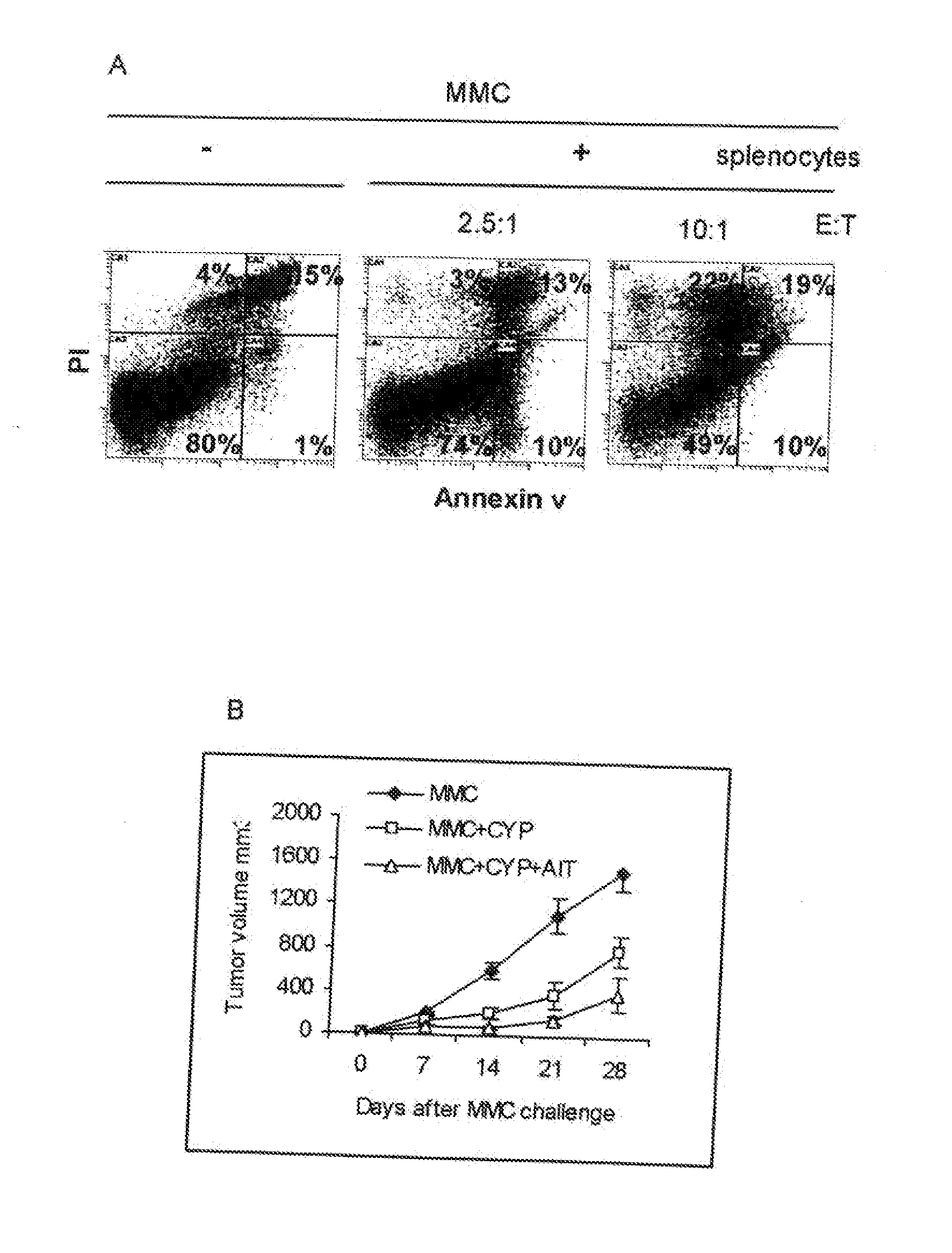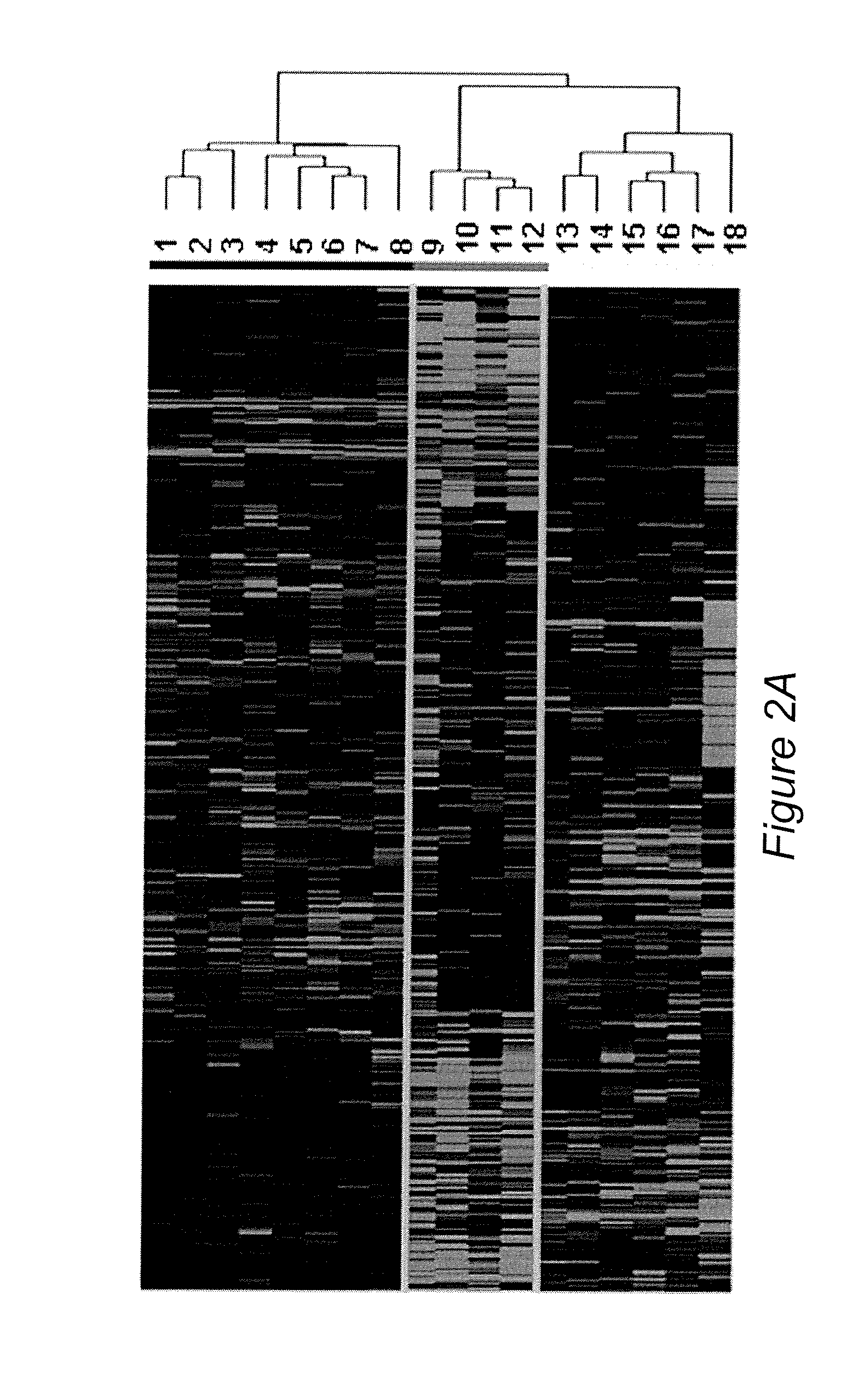Signatures Associated with Rejection or Recurrence of Cancer
- Summary
- Abstract
- Description
- Claims
- Application Information
AI Technical Summary
Benefits of technology
Problems solved by technology
Method used
Image
Examples
example 1
Signatures associated with rejection or recurrence in HER-2 / neu positive mammary tumors
[0063]Summary: We have previously shown T cell-mediated rejection of the neu-overexpressing mammary carcinoma cells (MMC) in wild-type FVB mice. However, following rejection of primary tumors, a fraction of animals experience a recurrence of a neu antigen-negative variant (ANV) of MMC (tumor evasion model), after a long latency period. In the present study, we determined that T cells derived from wild-type FVB mice can specifically recognize MMC by secreting IFN-γ and can induce apoptosis of MMC in vitro. Neu-transgenic (FVBN202) mice develop spontaneous tumors that they cannot reject (tumor tolerance model). To dissect the mechanisms associated with rejection or tolerance of MCC tumors, we compared transcriptional patterns within the tumor microenvironment of MMC undergoing rejection with those that resisted rejection either because of tumor evasion / antigen-loss recurrence (ANV tumors) or because...
example 2
Immune Function Gene Signatures in Human Breast Cancer
[0085]In order to validate signatures of immune function genes that had been detected in the animal (mouse) model of breast carcinoma, gene expression (RNA) in tumor lesions of human breast cancer patients who either remained relapse-free or developed relapse within 1-5 years after the initial treatment was analyzed. As shown in FIG. 7, unsupervised analysis of gene arrays from breast cancer patients compared to reference (control) human peripheral blood mononuclear cells (PBMCs) showed that relapse-free and relapse patients exhibit different, distinct clusterings of expressed genes. 9,797 genes were identified which exhibited at least a 3-fold change in expression between relapsed and relapse-free individuals.
[0086]Supervised analysis at p value<0.001 revealed upregulation of 50 genes in patients with relapse as well as upregulation of 299 genes in patients with relapse-free survival (FIG. 8). These genes are listed in tabular f...
example 3
Clinical Applications
[0089]During a routine mammogram or during routine self-examination, a “lump” is discovered in the breast tissue of a human patient. Biopsy samples are taken from the lump and from the surrounding tissue and it is determined that the patient has breast cancer. In addition to routine biopsy analysis, the samples are assessed using the methods of the invention to determine whether the patient is likely to relapse after treatment or is likely to be relapse free after treatment, as follows:
[0090]The results provided by the methods of the invention generally lead to two possible outcomes:
Outcome 1: Analysis of the gene expression patterns in the microenvironment of the tumor reveal a pattern of gene expression that is biased toward upregulation of the 299 genes listed in Table 4. As a result of this finding, the patient's health care team concludes that the prognosis for the patient (e.g. after removal of the tumor) is favorable, and that recurrence (relapse) is unli...
PUM
| Property | Measurement | Unit |
|---|---|---|
| Volume | aaaaa | aaaaa |
| Length | aaaaa | aaaaa |
| Length | aaaaa | aaaaa |
Abstract
Description
Claims
Application Information
 Login to View More
Login to View More - R&D
- Intellectual Property
- Life Sciences
- Materials
- Tech Scout
- Unparalleled Data Quality
- Higher Quality Content
- 60% Fewer Hallucinations
Browse by: Latest US Patents, China's latest patents, Technical Efficacy Thesaurus, Application Domain, Technology Topic, Popular Technical Reports.
© 2025 PatSnap. All rights reserved.Legal|Privacy policy|Modern Slavery Act Transparency Statement|Sitemap|About US| Contact US: help@patsnap.com



